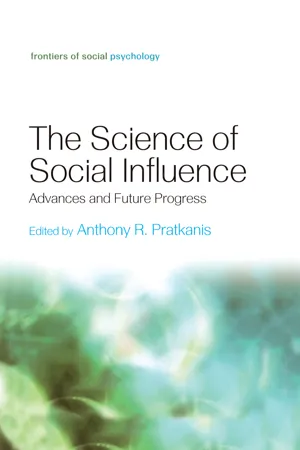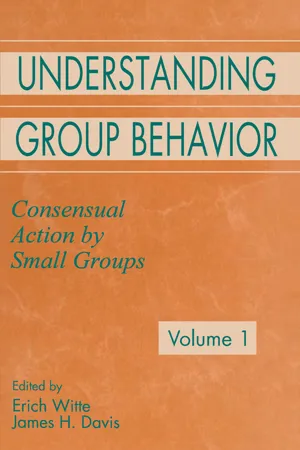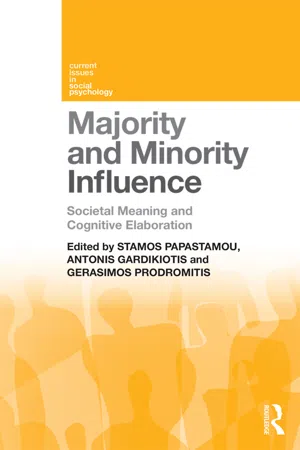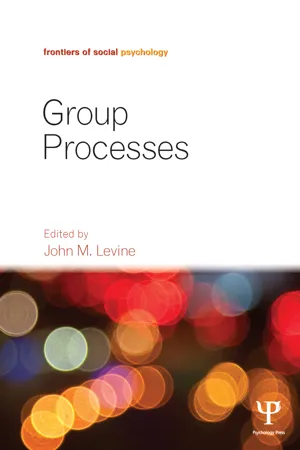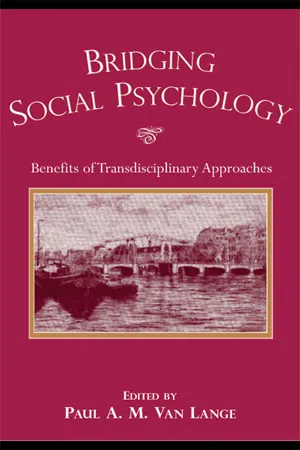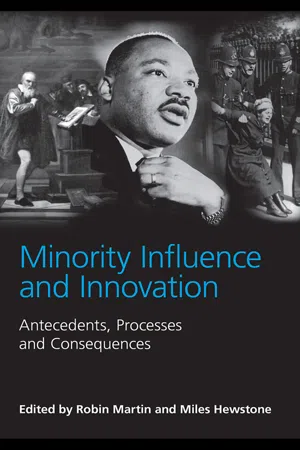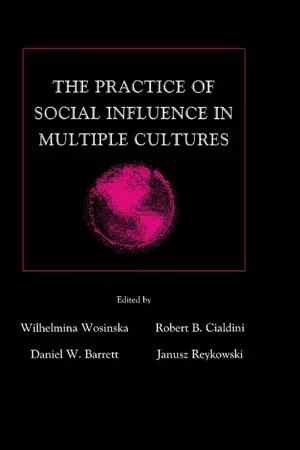Psychology
Minority Influence and Social Change
Minority influence refers to the ability of a small group to change the beliefs or behaviors of a larger group. This process can lead to social change when the minority group is consistent, confident, and flexible in their approach. It highlights the potential for individuals or small groups to challenge and shift prevailing social norms and attitudes.
Written by Perlego with AI-assistance
Related key terms
11 Key excerpts on "Minority Influence and Social Change"
- eBook - ePub
The Science of Social Influence
Advances and Future Progress
- Anthony R. Pratkanis, Anthony R. Pratkanis(Authors)
- 2011(Publication Date)
- Psychology Press(Publisher)
ad hoc work group changes the strategies the group uses, and thus their ultimate task performance (e.g., Choi & Levine, 2004).Underlying many of these and other changes we see in the ways group members think and behave is minority influence . Minority influence is the possible outcome of minority dissent , which occurs when a numerical minority faction in a group or society publicly advocates and pursues beliefs, attitudes, ideas, procedures and policies that go against the “spirit of the times” and challenge the position or perspective assumed by the majority (De Dreu & De Vries, 1997, 2001). Note that minority dissent refers to deviations from the majority point of view, and not to deviations from the majority in terms of social (cultural, religious) or demographic (gender, ethnicity) characteristics. Thus, although cultural or demographic differences may correlate with differences in opinion and point of view, the focus here is on opinion minorities and not on social minorities.That minority dissent can be influential follows from the fact that groups do not linearly progress towards a stable and finite equilibrium. What remains is when, how, and why minorities within a group or society influence the majority’s way of thinking and doing. It is these and related questions that are covered in this chapter.As an outline of the things to come, I will first discuss the nature and origins of minority influence: Why is it that some people do not comply with the majority perspective and instead go against the spirit of the times, and under what conditions is it more likely that minority influence emerges and comes into existence? In the second part of the chapter I will review several models, and their evidence, about the influence of minority statements on individual beliefs and attitudes. In the third section I will focus on the ways minority dissent in groups impacts work group processes and performance, and review research showing that minority dissent can actually promote creative thinking and innovative practices in work groups. I conclude with some avenues for future research that I think are worth pursuing. - eBook - ePub
Towards Constructive Change in Aboriginal Communities
A Social Psychology Perspective
- Donald M. Taylor(Author)
- 2014(Publication Date)
- McGill-Queen's University Press(Publisher)
Our intention is not only to appreciate the magnitude of the challenges but also to seek realistic and targeted solutions. Our solutions are targeted in that they are rooted in the specific social and psychological challenges discussed earlier. And, again, we need to emphasize that what we propose is a theoretical framework for social change, not the actual cultural content of that change.In the next three chapters we propose three interrelated tools for addressing the challenges confronting Aboriginal communities. In this chapter we discuss the social psychology of minority influence. We argue that there is a minority of Aboriginal people in each community, the 20 percent, who have the psychological resources to potentially reverse the current normative structure. Understanding the functioning of minority influence will provide us with the guiding principles for constructive social change. In Chapter 8 we examine “zero tolerance.” We argue that zero tolerance is a misunderstood policy and that, if applied correctly, it may provide a mechanism for changing entrenched destructive norms. In Chapter 9 we discuss a concrete community-based process that makes use of survey research. Because a survey research instrument can, under special circumstances, involve sampling every member of a community, and because there is the potential for in-depth feedback, we believe that, through its use, it is possible to instigate constructive, and indeed revolutionary, social change in very dysfunctional communities. In these three chapters, we argue that if we apply these interventions it is possible to reverse the current normative structure in Aboriginal communities.MINORITY INFLUENCE
How do each of us, as individuals, know what to think, how to feel, and how to behave, or at least how we are supposed to think, feel, and behave? The physical environment offers few answers, except perhaps when to dress warmly, when to put on sunscreen, or when to avoid crossing a busy street. When it comes to important matters – our values, beliefs, and, indeed, our entire worldview – the only source of information is other people - eBook - ePub
Social Groups in Action and Interaction
2nd Edition
- Charles Stangor(Author)
- 2015(Publication Date)
- Routledge(Publisher)
To this point, our discussion of majority influence might make it seem that individuals always prefer to conform to the opinions of others. But the assumption that all social behavior is driven by goals of conformity is problematic. For one, there are clear cases in which a smaller number of individuals (a minority group) are able to influence the opinions or behaviors of a larger group of individuals (Gardikiotis, 2011; Moscovici, Mucchi-Faina, & Maass, 1994). Teachers are able to change the beliefs of their students, and political leaders are able to change the behavior of their followers. And when we look back on history, we find that it is the unusual, divergent, innovative minority groups or individuals, who, although frequently ridiculed at the time for their unusual ideas, end up being respected in the end for producing positive changes.Although conformity to majority opinions is essential to provide a smoothly working society, if individuals only conformed to others there could never be any new ideas or social change. It is popularly said that dissent “opens the mind” and research on minority influence has demostrated that the axiom is correct. When people are exposed to the opinions of people who express different viewpoints than they do they begin to search for information, consider more options, make better decisions and are more creative (Nemeth & Goncalo, 2010). Innovation in all areas of group process requires that minorities, whether they be leaders, popular group members, or those with the best ideas and the newest insights be able to successfully change group opinion (Bazarova, Walther, & McLeod, 2012; De Dreu, De Vries, Franssen, & Altink, 2000).Minority Influence in ActionThe French social psychologist Serge Moscovici was particularly interested in the situations in which minority influence might occur. In fact, he argued that all members of all groups are able (at least in some degree) to influence others, regardless of whether they are in the majority or the minority. To test whether minority group members could indeed produce influence, Moscovici, Lage, and Naffrechoux (1969) essentially created the reverse of Asch’s line perception study, such that there was now a minority of confederates in the group (two) and a majority of experimental participants (four). All six individuals viewed a series of slides depicting colors, supposedly as a study of color perception, and as in Asch’s research, each gave an opinion about the color of the slide out loud. - eBook - ePub
Understanding Group Behavior
Volume 1: Consensual Action By Small Groups; Volume 2: Small Group Processes and Interpersonal Relations
- Erich H. Witte, James H. Davis(Authors)
- 2013(Publication Date)
- Psychology Press(Publisher)
With a growing number of colleagues and collaborators, he has opened our eyes to a variety of new and paradoxical phenomena that seem to show that when it comes to social influence, there can be strength from weakness, thereby challenging the foundational assumptions of social psychology. The phrase minority influence has become pervasive in the attitude change literature, framing the way we talk and think about these fascinating questions and stimulating a recent outpouring of summaries, extensions, reviews, and critiques (e.g., Kruglanski & Mackie, 1990; Levine & Russo, 1987; Maass, West, & Cialdini, 1987; Mugny & Perez, 1991). Why is the Minority Influence Concept so Appealing? Although a number of empirical studies show minority influence effects, the results have often proved difficult to replicate, confusing, and/or interpretable in more conventional theoretical terms (Turner, 1991). I do not here review the provocative but controversial theoretical and empirical arguments for and against this concept, but merely cite three powerful (if not entirely legitimate) reasons why people may believe in minority influence. Wishful Thinking. Social scientists, European and American both, have a soft spot in their heart for minorities. In addition to a general tendency to root for the underdog, many of us are members of ethnic minorities and virtually all of us, as academic social scientists who live in a world that undervalues what we do and in a discipline that overvalues originality, are members of opinion minorities - eBook - ePub
- Jane Callaghan, Lisa Lazard(Authors)
- 2011(Publication Date)
- Learning Matters(Publisher)
However, much research that has developed Moscovici’s premise has focused on individual cognitive processes rather than group dynamics. So, for example, Levine and Kaarbo (2001) suggest that the dominant approach to studying minority influence involves looking at the individual cognitive responses of majority members to a (often anonymous) person who holds a minority view. These studies explore how this apparent ‘minority’ influences attitude change (for example, Alvaro and Crano, 1996 ; Martin and Hewstone, 2003), or other aspects of cognition like problem-solving (for example, Smith et al., 1996 ; Van Dyne and Saavedra, 1996). For example, Martin et al. (2007) conducted experiments to explore the differential impact of majority and minority influence on attitude-consistent behavioural intentions. They set up experimental conditions to explore whether minority or majority influence would have a bigger impact on the likelihood of people expressing behavioural intentions that were consistent or inconsistent with their existing attitudes. For example, participants read a counter-attitudinal message (opposed to voluntary euthanasia), and were asked to indicate whether they would sign an advance directive or ‘living will’, which would be used to prevent them from being kept alive under particular medical circumstances. Participants were told that the statement they read had been written either by a minority or a majority member - eBook - ePub
Majority and Minority Influence
Societal Meaning and Cognitive Elaboration
- Stamos Papastamou, Antonis Gardikiotis, Gerasimos Prodromitis(Authors)
- 2017(Publication Date)
- Routledge(Publisher)
We would like to recall here that according to Lemaine the social comparison process, which as a rule leads to social consensus and uniformity (Festinger, 1954), under certain circumstances may, conversely lead to social differentiation and social change: when, that is, the social subject under comparison is deficient in social status, socio-psychological profile and/or available resources with regard to the others, in order to retain its psychosocial identity in a first phase, it endeavours to be rendered incomparable thereby creating some new criterion of comparison while it then tries to impose this new criterion as the dominant one, which would enhance its general social standing. The explanatory value of this process when applied in the context of the scientific community is, we think, obvious. Scientific innovation and the theoretical and methodological leaps and bounds accompanying it no longer derive from the purely epistemological since it is subject to the uncertain but inevitable arrival of new ‘enlightened minds’. It is defined to a great extent by the correlation of forces governing the relations between the members of a same scientific community or between different scientific communities and which can change under the influence of a series of complex socio-psychological processes like the one we have just described. In this sense, the specific perspective introduces indirectly but clearly an additional element which opens the way to a new view of the emergence of a new epistemological paradigm, even to the simple change in methodological and theoretical orientation. A view that takes into account the socio-psychological dynamics of the scientific community which it includes in the broader context of social influence processes, given that, as is well known, social comparison – in its various variations – constitutes an integral part of it.The questions, therefore, that we shall try to answer through the examination of majority and minority influence, come from the following four groups of research:a) ‘classic’ research on social conformity (see by way of indication Asch, 1951, 1956; Kelman, 1958) and the ‘heterodox’ experiments conducted by Moscovici and his associates on innovation (see by way of explanation Moscovici, 1976b, 1980, 1985; Mugny, 1982; Mugny & Pérez, 1991; Nemeth, 1986; Nemeth & Kwan, 1987; Nemeth & Wachtler, 1983; Papastamou, 1983, 1986; Papastamou & Mugny, 1990; Pérez & Mugny, 1996);b) research leaning towards dispute of the distinctiveness of the minority influence processes (see by way of indication Doms & Van Avermaet, 1980; Maass & Clark III, 1983, 1984; Latané, 1981; Wolf & Latané, 1983; Trost, Maass & Kenrick, 1992);p.12c) research that introduces the study of minority and majority influence methods and theoretical thinking that are the nature of research into persuasion phenomena (see by way of indication De Dreu & De Vries, 1993; Martin & Hewstone, 2003, 2001, 2008; Bohner, Frank & Erb, 1998);d) research - eBook - ePub
- John M. Levine(Author)
- 2012(Publication Date)
- Psychology Press(Publisher)
Another personal goal is the desire to be liked and accepted by the majority. Because minority members may fear that complete agreement with the majority will be perceived as sycophancy, they may use compromise, or partial conformity, to ingratiate themselves with the majority (Schlenker, 1980). Finally, minority members may be less concerned about how the majority views them than about how they view themselves. In particular, minority members’ desire to feel distinctive or unique may cause them to nonconform in one way or another (Hornsey & Jetten, 2004 ; Imhoff & Erb, 2009). Challenging the Status Quo: Minority Influence For all its insights and dramatic demonstrations of the human capacity to conform, the dependence approach to social influence has limited explanatory power. This is because it cannot account for the persistent diversity of opinions within society or for their sometimes dramatic evolution from marginality to orthodoxy. Clearly, these phenomena are difficult, if not impossible, to explain if minorities are always dependent on majorities for information about reality and social acceptance. The first social psychologist to identify the limited scope of the dependence approach for understanding social influence was Serge Moscovici (see Moscovici & Faucheux, 1972). Moscovici’s genius was in recognizing that people holding a minority position in a group are not always silenced by pressure to conform but instead sometimes produce social change, or innovation. To engender innovation, according to Moscovici, minority dissent must entail more than passive resistance to prevailing group norms. It must include a well-articulated alternative viewpoint that is actively promoted through engagement and conflict with the majority - eBook - ePub
Bridging Social Psychology
Benefits of Transdisciplinary Approaches
- Paul A.M. Van Lange(Author)
- 2006(Publication Date)
- Psychology Press(Publisher)
These issues could be explored in laboratory settings prior to testing them in field settings. Now we turn to examine the potential value of this approach at the organizational level. MINORITY INFLUENCE, EMPOWERMENT, AND ORGANIZATIONAL CHANGE We can apply the research of minority influence to gain new perspectives on organizational change. Most academic and practitioner models of organizational change take a “top down” perspective, neglecting to consider how minorities and those at the lower echelons in organizations—say, a team of hospital nurses wanting to have more responsibility for diagnosis and treatment decisions—can bring about change. Social psychological researchers have treated minorities as just that—numerical minorities. However, it may well be that those in positions of relative powerlessness, regardless of their numerical superiority or inferiority, could also be considered a minority that, by dissenting, provokes creative processing of issues by those they seek to influence. Indeed, Nemeth’s recent work implies that the courage of the dissenting group leads others to process the issues under discussion more creatively than they otherwise would. I suggest that those who are relatively powerless (nurses in health care organizations) will have the same impact as minorities on the relatively powerful (e.g., doctors) through dissent, despite the fact that they are in a numerical majority. The courage of the relatively powerless (not all minorities are powerless) rather than the numerical ratio between opposing groups may be the important element in “minority” influence processes. With that in mind, we now examine a clear strategy for those in minorities or relatively powerless positions to bring about change in the face of resistance from a majority or from a relatively powerful minority - eBook - ePub
Minority Influence and Innovation
Antecedents, Processes and Consequences
- Robin Martin, Miles Hewstone(Authors)
- 2009(Publication Date)
- Psychology Press(Publisher)
71 , 1181–1193.Wood, W., & Quinn, J.M. (2003). Forewarned and forearmed? Two meta-analysis syntheses of forewarnings of influence appeals. Psychological Bulletin , 129 , 119–138.Wright, M.J. (2005). Saliency predicts change detection in pictures of natural scenes. Spatial Vision , 18 , 413–430.Passage contains an image
4 Consensus as the key: Towards parsimony in explaining majority and minority influence
Hans-Peter Erb Helmut Schmidt University, GermanyGerd Bohner University of Bielefeld, GermanyIntroduction
It is literally impossible to go through life without being influenced by other people. Social influence, in particular, is closely related to the number of those other people who express or advocate a particular view or position. Research has long been concerned with conformity as the psychological process to explain the influence by a large number or majority of others (see Cialdini & Trost, 1998). Since Moscovici’s work (e.g., Moscovici, Lage, & Naffrechoux, 1969) it has also been known that minorities who hold positions shared by only a few others can exert considerable influence. The number of studies on majority and minority influence is large, and they often provide conflicting findings. Moreover, comparisons between studies are difficult because the effects of majorities and minorities have been studied with multiple operationalizations (see Wood, Lundgren, Ouellette, Busceme, & Blackstone, 1994).Recently, we have made attempts at integration to explain social influence with the most basic variable that was found to necessarily covary with majority or minority status, namely consensus - eBook - ePub
- Miles Hewstone, Wolfgang Stroebe, Miles Hewstone, Wolfgang Stroebe(Authors)
- 2021(Publication Date)
- BPS Blackwell(Publisher)
To summarize, there is clear support for Moscovici’s (1980) proposal that we should study the influence of minorities as well as majorities. However, there is mixed support for his theory, as there is for self‐categorization theory’s prediction that only ingroup minorities will have an impact. There is evidence that both majorities and minorities can instigate detailed processing of their messages, under specific circumstances, and that both ingroup and outgroup minorities can exert influence; typically, however, the influence of ingroup minorities will be greater, and it will be shown primarily on indirect private measures of influence and on measures of divergent thinking.One final observation we make about research on minority influence is that how and where we do research may have underestimated the impact of minorities (Hewstone & Martin, 2010). For example, while the meta‐analysis carried out by Wood et al. (1994) found that minority influence is more likely to be indirect rather than direct, is more frequently found in private rather than public contexts, and tends to be delayed rather than immediate, this may not be the case when we study influence processes in freely interacting groups, which allow for reciprocal exchange between minority and majority members, and especially when consensus must be reached (see Smith & Tindale, 2010). Research conducted using freely interacting groups has shown that the presence of a minority source of influence brings about a change in how the group considers and treats the evidence before it (see Schulz‐Hardt, Frey, Lüthgens, & Moscovici, 2000), and, generally, this is associated with an improvement in the group’s products or decisions (e.g., Brodbeck, Kerschreiter, Mojzisch, Frey, & Schulz‐Hardt, 2002; see Chapter 13 - Wilhelmina Wosinska, Robert B. Cialdini, Daniel W. Barrett, Janusz Reykowski(Authors)
- 2000(Publication Date)
- Psychology Press(Publisher)
In summary, although it may be desirable to facilitate of social change on a global level, the process of change in a transitional society occurs in an uneven manner, with local environments most susceptible to intervention strategies. Agents of change should thus concentrate their effects on pockets of society containing preferences for the new agenda. This in effect creates seeds that may grow to form clusters. If these clusters develop connections with each other, there is a chance that the new agenda will overcome the old. This perspective suggests that the future may often co-exist with the present. Some elements of the diversity that surrounds us may in fact be harbingers of future global states of the system. However, it may be very difficult to say at present which local clusters provide a window on the future and which are simply aberrations that will pass without leaving any traces.SUMMARY AND CONCLUSIONS
Many specific mechanisms of social influence have been shown to operate at the level of individuals (cf. Cialdini, 1988). Regardless of the specific means by which influence is exerted on individuals, the social context plays an important role in determining whether such influence will result in change and an even more important role in determining whether any resultant changes will persist in the face of subsequent opposing influences. Such factors as distribution of leaders, size of the group with a particular position, structure of communication networks, timing of intervention, and importance of the issue in question should be taken into account when trying to induce change in groups or societies. In general, social influence attempts are likely to be most effective when they follow the natural course of social change as it occurs in social interactions. It is possible for a minority to induce social change if the minority concentrates first on creating bubbles of new and then expanding them, rather than trying to induce global change.The computer simulation approach has already provided some important insights into how best to facilitate social change. Many issues remain unresolved, however, and await further simulation as well as empirical work. For example, if the strongest minority leaders can travel, what route would be most effective for purposes of inducing social change? Should they try to expand the borders of strongholds or should they create new passages between existing strongholds? If a communication structure can be shaped, what is the best structure for maintaining minority position? What is the best structure for expansion? How should the communication structure change to enable the survival of minority clusters in the beginning and to provide for expansion after such clusters have achieved coherence? Perhaps of greatest importance, however, will be efforts devoted to bridging the gap between abstract theoretical models suggested by computer simulations and concrete strategies of social influence.
Index pages curate the most relevant extracts from our library of academic textbooks. They’ve been created using an in-house natural language model (NLM), each adding context and meaning to key research topics.
